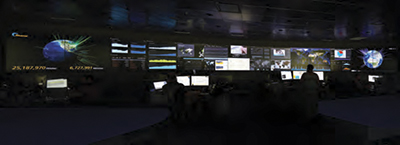Content may be king, but it would have little over which to rule without the advent of Akamai.
Akamai monitors and maintains 140,000 servers over 1,190 different networks from its Network Operations Command Center, a highly advanced environment where AV, ergonomics, information, and even marketing all coalesce on a 24/7 basis.The company that launched in 1998 out of an MIT experiment has grown into an indispensable cloud platform for web experiences. Scan a list of the top entertainment companies, retailers, news portals, and all five branches of the U.S. military, and you’ll see Akamai’s servers and networks form their internet backbone.
Ensuring that all those music downloads, streaming videos, and shopping cart transactions move without a hiccup requires a full-fledged command center. In Cambridge, MA, Akamai now monitors and maintains 140,000 servers over 1,190 different networks from its brand-new Network Operations Command Center, a highly advanced environment where AV, ergonomics, information, and even marketing all coalesce on a 24/7 basis.
Typically there are no more than 10 people working in Akamai’s Cambridge facility, which stands as the mother ship NOCC among several others that the company maintains worldwide. Video considerations were a top priority in enabling this small group to function at maximum speed, and resolve the hundreds of service alerts that may arise every hour.
“Our tools are specifically designed to be efficient,” said Eric Buda, director of platform operations for Akamai. “Having enough real estate on the screens, so we can accommodate a lot of information on the display walls, is key. If people want to look up and see if a newly installed server is having a negative impact on the network, for example, that has to be available at a glance—and not be something that you have to dig for.”
The designer/integrator for the new NOCC was Constant Technologies, a Rhode Island-based firm specializing in turnkey command center solutions. Constant Technologies’ lead on the project was Tom Sheeran, vice president of sales and project management, who also helped construct Akamai’s first NOCC in 1999. While that NOCC and a subsequent one had served well, big advances in AV were just one of many motivating factors in deciding to build a new facility.
“A command center is the nerve center of organizations—the equipment you’re putting in there needs to support a mission-critical environment that will run 24/7 with no down time,” said Sheeran. “In addition, you need to take into account the environmental hand you’re dealt in terms of ceiling height and space constraints, while trying to meet the needs of the end users.
“There are a lot of things to consider in terms of the displays, including their size, display wall processing, control systems, and redundancy. All those aspects are taken into account when designing and choosing the AV products for these types of centers.”
Resembling an elongated egg when viewed from above, the 1,500-square-foot NOCC serves a dual purpose. In addition to being the center for network operations and maintenance, it’s also an important marketing device for Akamai: guided tours for current and potential clients take place several times a week, increasing the need for an elegantly functional feel.
The aesthetic starts with the curved screen display wall, a two-high by 14-wide configuration of Planar MX-55HD-L matrix wall displays. But their beauty is more than screen deep—all displays feature an off-board architecture that has the power supplies and electronics located remotely in the AV racks, a design that provided Akamai with significant construction and environmental savings. Behind the scenes, the display wall is driven by a Jupiter Fusion Catalyst 8000 Display Wall Processor with automatic, redundant PC backup.
Within the NOCC, 12 pod-style workstations are grouped together in sets of three. The configuration enhances collaboration among user groups, including sit/stand capability and adjustable monitors for superior ergonomics and ease of use. The system engineers have access to an Extron XTP Matrix Switch and AMX Control System with iPad integration for control and switching. Meanwhile, the rear two tables are utilized for marketing tours and a shift turnover area.
In addition, the NOCC features integrated ClearOne and LifeSize audio/video conferencing, and multi-zone audio systems for collaboration with Akamai’s other global NOCC locations. Audio, which plays out over Extron SI 26 SI ceiling speakers in the NOCC, serves myriad other functions there as well. “If we have what we call a Priority One alert, there’s a sound that plays to alert everybody that something critical has happened,” said Buda. “We also stream media, so certain types of events we might bring up to monitor the event for audio streaming, such as the World Cup or the Olympics.
At the new Akamai NOCC, well-executed AV helps assure that a significant percentage of the internet operates glitch-free. “With our specific needs here, we can’t have people hunting for things,” Eric Buda stated. “The right information needs to be displayed where it’s needed, adapt dynamically to a situation that arises, and be simple for the operator to understand.”
David Weiss (www.dwords.com) writes extensively about AV, audio, and broadcast technology.
